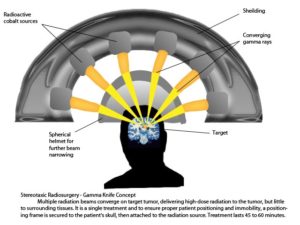
Gamma Knife radiosurgery employs targeted, highly-focused gamma rays to treat tumors and lesions. As a result, the surgery is non-invasive with minimal impact on surrounding brain tissue.
What is it?
Gamma Knife surgery is a safe and effective alternative to traditional brain surgery when treating tumors, lesions, and other cerebral abnormalities. Once focused on a single point, this targeted gamma radiation destroys the abnormal cells within a tumor, lesion, or artery. The effects of Gamma Knife surgery are not immediate but rather, accumulate over time. Traditional brain surgery, however, is both required and preferred for patients needing emergency or urgent care.
What should I do to prepare?
Before radiosurgery, patients will undergo a physical examination, blood, and other diagnostic tests. Patients should notify their surgeon of any bleeding disorders, implants, or other physical conditions. They will also use a special, antimicrobial shampoo in the days prior to surgery and your head will likely be shaved. Patients should talk to their doctor to determine which medications should be stopped prior to surgery. Patients cannot eat or drink anything the night before your surgery.
What happens during the process?
Gamma Knife radiosurgery destroys the DNA of abnormal cells in the brain. Cells in a tumor, for example, cannot continue to grow, reproduce or divide if their DNA is damaged or destroyed and so, the tumor will shrink over time as the cancerous cells die. In the case of a lesion, the blood vessels will close, and damaged tissue begins to heal. During the procedure, the patient will have a head frame holding their head in a fixed position. This allows the gamma radiation to focus precisely on the intended cells and avoid harming healthy brain tissue. MRI, or CT, scans help guide the surgeons aiming the beams. A helmet is then placed on the head frame to direct the gamma radiation onto the targeted cells. This procedure may last anywhere from several minutes to hours based on the size, location, and type of cerebral abnormality. Typically, only one Gamma Knife session is required to treat the abnormality successfully .
What are the risks and potential complications?
Being that this is a non-invasive procedure, the complications and risks are much less intense than those involved with invasive brain surgery. Some associated risks and complications for Gamma Knife Radiosurgery are headache, nausea, numbness, swelling of the brain, fatigue, scalp and hair problems, seizures, vision problems, and loss of balance.
Disclaimer:
All GlobeHealer Site content, including graphics, images, logos, and text, among other materials on the site are for educational purposes only. This content is not intended to be a substitute for professional medical advice, and you should always contact your physician or qualified health provider for information regarding your health. Information on this site regarding the overview, diagnosis, and treatment of any kind should be looked at, in addition to the advice and information of your health care professional. Do not disregard medical advice or delay seeking treatment or medical advice due to information found on the GlobeHealer site. If there is even the possibility that you may have a medical emergency, seek treatment, call your doctor, or call your local emergency telephone number immediately. GlobeHealer does not endorse being the first line of communication in case of emergency and does not endorse any specific test, physician, facility, product, procedure, opinion, or other information that is or may be mentioned on this site or affiliated entities. Reliance of any and all information provided by GlobeHealer, its employees, affiliations, others appearing on the Site under the invitation of GlobeHealer, or visitors of the site is solely at your own risk and is not the responsibility of GlobeHealer.
Image Source: https://upload.wikimedia.org/wikipedia/commons/b/b6/Gammaknife.jpg
